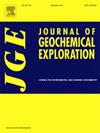物源—沉积裂片与铀矿化的关系——以松辽盆地北部为例
IF 3.3
2区 地球科学
Q1 GEOCHEMISTRY & GEOPHYSICS
引用次数: 0
摘要
松辽盆地北部四方台组铀矿化分布广泛,其铀储层砂体成因复杂,对铀矿预测和找矿具有重要制约作用。松辽盆地北部四方台组铀矿化分布广泛,其铀储层砂体成因复杂,严重制约了铀矿预测与找矿。本文采用砂岩地球化学、重矿物分析、碎屑锆石UPb年代学等综合研究方法,对松辽盆地北部四方台组铀储层砂体物源进行了准确溯源。研究结果表明,四方台组砂岩中石英、长石和岩屑的平均含量分别为42%、37%和21%,CIA为61.81 ~ 72.81,平均值为68.56。四方台组砂岩重矿物磷灰石—电气石指数(ATi)多大于50,石榴石—锆石指数(ZGi)多小于50,重矿物稳定系数(ZTR)在9.63% ~ 35.78%之间。碎屑锆石的主峰值集中在侏罗系—二叠系,年龄范围为165 ~ 294 Ma,次峰值集中在白垩纪,年龄范围为92 ~ 148 Ma。研究认为,四方台组铀储集层为灰长砂岩和长石砂岩,母岩来自上地壳,为活动大陆边缘形成的二叠系—侏罗系和早白垩系中酸性岩浆岩。四方台组西部物源由大兴安岭提供,北部物源由小兴安岭提供,东部物源由张广财山提供。松辽盆地北部西、北、东3个物源—沉积裂片控制着铀储层的发育,形成了四方台组源—汇体系。3个物源-沉积裂片具有不同的铀矿化潜力,其中西部物源-沉积裂片的成矿潜力最大。本文章由计算机程序翻译,如有差异,请以英文原文为准。
Relationship between provenance-deposition lobes and uranium mineralization: A case study from the northern Songliao basin
The uranium mineralization in the Sifangtai Formation of the northern Songliao Basin is widely distributed, and the complex origins of its uranium reservoir sand bodies pose significant constraints on uranium deposit prediction and exploration. The uranium mineralization in the Sifangtai Formation of the northern Songliao Basin is extensively distributed, with the complex origins of its uranium reservoir sand bodies posing severe constraints on uranium deposit prediction and exploration. This paper employs comprehensive research methods, including sandstone geochemistry, heavy mineral analysis, and detrital zircon U![]() Pb geochronology, to accurately trace the provenance of uranium reservoir sand bodies in the Sifangtai Formation of the northern Songliao Basin. The research results indicate that the average content of quartz, feldspar, and rock debris in the sandstone of the Sifangtai Formation is 42 %, 37 %, and 21 %, and the CIA is from 61.81 to 72.81 with an average of 68.56. The apatite-tourmaline index of heavy minerals (ATi) in the sandstone of the Sifangtai Formation are mostly greater than 50, the Garnet-Zircon index of heavy minerals (ZGi) is mostly less than 50, and the stable coefficient of heavy minerals (ZTR) ranges from 9.63 % to 35.78 %. The main peak value of detrital zircon is concentrated in the Jurassic-Permian, with ages ranging from 165 to 294 Ma, and the secondary peak is concentrated in the Cretaceous, with ages ranging from 92 to 148 Ma. This study indicates that the uranium reservoirs of the Sifangtai Formation are greywacke and feldspathic sandstone, with the parent rock originating from the upper crust and being the Permian-Jurassic and Early Cretaceous medium acidic magmatic rocks formed in the active continental margin. The western provenance of the Sifangtai Formation is provided by the Daxing'an Moutains, the northern provenance is supplied by the Xiaoxing'an Moutains, and the eastern provenance is offered by the Zhangguangcai Mountains. The source-to-sink system of the Sifangtai Formation has led to the formation of three provenance-deposition lobes in the west, north and east of the northern Songliao Basin, which control the development of the uranium reservoirs. The three provenance-deposition lobes show different uranium mineralization potential, in which the western provenance-deposition lobe has the highest metallogenic potential.
Pb geochronology, to accurately trace the provenance of uranium reservoir sand bodies in the Sifangtai Formation of the northern Songliao Basin. The research results indicate that the average content of quartz, feldspar, and rock debris in the sandstone of the Sifangtai Formation is 42 %, 37 %, and 21 %, and the CIA is from 61.81 to 72.81 with an average of 68.56. The apatite-tourmaline index of heavy minerals (ATi) in the sandstone of the Sifangtai Formation are mostly greater than 50, the Garnet-Zircon index of heavy minerals (ZGi) is mostly less than 50, and the stable coefficient of heavy minerals (ZTR) ranges from 9.63 % to 35.78 %. The main peak value of detrital zircon is concentrated in the Jurassic-Permian, with ages ranging from 165 to 294 Ma, and the secondary peak is concentrated in the Cretaceous, with ages ranging from 92 to 148 Ma. This study indicates that the uranium reservoirs of the Sifangtai Formation are greywacke and feldspathic sandstone, with the parent rock originating from the upper crust and being the Permian-Jurassic and Early Cretaceous medium acidic magmatic rocks formed in the active continental margin. The western provenance of the Sifangtai Formation is provided by the Daxing'an Moutains, the northern provenance is supplied by the Xiaoxing'an Moutains, and the eastern provenance is offered by the Zhangguangcai Mountains. The source-to-sink system of the Sifangtai Formation has led to the formation of three provenance-deposition lobes in the west, north and east of the northern Songliao Basin, which control the development of the uranium reservoirs. The three provenance-deposition lobes show different uranium mineralization potential, in which the western provenance-deposition lobe has the highest metallogenic potential.
求助全文
通过发布文献求助,成功后即可免费获取论文全文。
去求助
来源期刊

Journal of Geochemical Exploration
地学-地球化学与地球物理
CiteScore
7.40
自引率
7.70%
发文量
148
审稿时长
8.1 months
期刊介绍:
Journal of Geochemical Exploration is mostly dedicated to publication of original studies in exploration and environmental geochemistry and related topics.
Contributions considered of prevalent interest for the journal include researches based on the application of innovative methods to:
define the genesis and the evolution of mineral deposits including transfer of elements in large-scale mineralized areas.
analyze complex systems at the boundaries between bio-geochemistry, metal transport and mineral accumulation.
evaluate effects of historical mining activities on the surface environment.
trace pollutant sources and define their fate and transport models in the near-surface and surface environments involving solid, fluid and aerial matrices.
assess and quantify natural and technogenic radioactivity in the environment.
determine geochemical anomalies and set baseline reference values using compositional data analysis, multivariate statistics and geo-spatial analysis.
assess the impacts of anthropogenic contamination on ecosystems and human health at local and regional scale to prioritize and classify risks through deterministic and stochastic approaches.
Papers dedicated to the presentation of newly developed methods in analytical geochemistry to be applied in the field or in laboratory are also within the topics of interest for the journal.
 求助内容:
求助内容: 应助结果提醒方式:
应助结果提醒方式:


